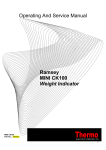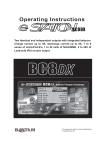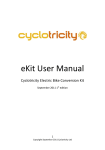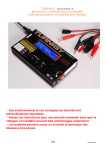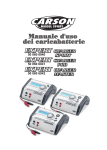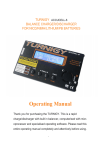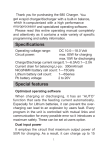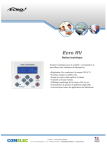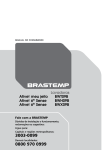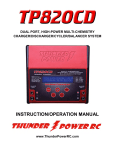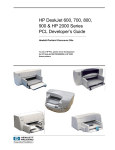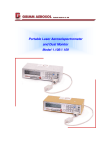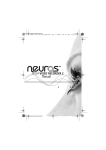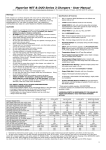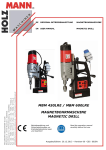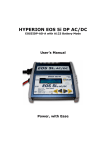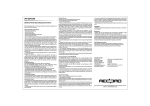Download Operating Manual of the charger E6D Manual of the
Transcript
Manual of the charger E6D
Operating Manual of the charger E6D
Microprocessor controlled high-performance rapid
charger/discharger for NiCd/NiMH/Lithium/Pb batteries. Dual
input power (50W/AC, 90W/DC), temperature sensor and
integrated Lithium battery balancer
Charger current: 0.1-6 A
LiPo/LiFe/Lilo: 1 - 6 series
Pb( Lead-acid): 2 - 22 V
Discharger current: 0.1- 1 A
NiCd/NiMH: 1 - 15 cells
Manual of the charger E6D
Contents
1. Special features -------------------------------------------------------------- 1
2. Exterior of the charger ----------------------------------------------------- 2
3. Warnings and safety notes ----------------------------------------------- 3
4. Program flow chart ---------------------------------------------------------- 5
5. The first display ------------------------------------------------------------ 6
6. Initial parameter set up --------------------------------------------------- 6
7. Lithium battery ( Lilo/LiPo/LiFe) program ----------------------------- 8
7.1 Parameter set-up for Lithium battery(Lilo/LiPo/LiFe) –---------------------------------------- 8
7.2 Select program and start the process ----------------------------------------------------------- 10
8. NiMH/NiCd battery program -------------------------------------------- 11
8.1 Parameter set-up for NiCd/NiMH battery ------------------------------------------------------- 11
8.2 Select program and start the process ----------------------------------------------------------- 13
9. Pb (Lead-acid) battery program --------------------------------------- 14
9.1 Parameter set-up for Pb battery ------------------------------------------------------------------ 14
9.2 Select program and start the process ----------------------------------------------------------- 15
10. Screen displays during process -------------------------------------- 15
11. Review the date after finishing the progress —------------------- 16
12. Warning and error messages ----------------------------------------- 17
13. Battery status view ---------------------------------------------------- 19
14. Glossary of terms ------------------------------------------------------- 19
15. Specifications ------------------------------------------------------------ 20
16. Warranty and service --------------------------------------------------- 20
Manual of the charger E6D
1. Special features
Operating software
The operating program in this charger is executed with mutual links and communications
with every component to prevent any possible error, so it introduces the maximum safety.
Especially, the charging algorithm is so multifarious that you can select the best program
to suit your requirement. And E6D has a large LCD for showing various information
including charge/discharge graphs during the process.
Dual input power
E6D employs the circuit that can be operated at AC(Alternating Current) or DC( Direct
Current) input power. For AC input, the charger contains a AC-DC switching power
supplier inside, which has maximum output power of 50 watts for charging. But in DC
input, the charger's maximum output power of 90W. The charger can charge up to 15 cells
of NiCd/NiMH and 6 series of Lithium batteries. There may be the limit of feeding current
to a higher voltage of battery by chargers wattage.
Maximum safety
Delta-peak sensitivity: The automatic charge termination program works on the principle of
the Delta-peak voltage detection.(NiCd/NiMH)
Auto-charge current limit: When charging NiCd or NiMH at “AUTO” current mode, you can
set the upper limit of charge current to avoid from feeding high current to the battery. This
is very useful when charging the low impedance and small capacity NiMH battery in
“AUTO” model.
Capacity limit: The charging capacity always calculated by multiple of the charging current
and time. If the charging capacity exceeds the limit the process will be terminated
automatically when you set the maximum value.
Temperature limit: The temperature of the battery on charging or discharging will be raised
by its internal chemical reaction. If you set the limit of temperature the process will be
expired forcibly when the limit has been reached.
Processing time limit: You can also restrain the maximum processing time to prevent any
possible defect.
Cyclic charging /discharging for NiMH/NiCd battery
Perform 1 to 10 cycles of charge >discharge or discharge> charge continually for battery
refreshing and balancing.
1
Manual of the charger E6D
2. Exterior of the charger
Cooling Fan
LCD screen
128x64 dot matrix
AC Input power
(AC 100~240V,50/60Hz)
Input (11-18V DC)
Power cable
Balance port
Temperature
sensor port
OUTPUT
STOP/ESC
buttons
UP/DOWN
buttons
DEC/INC
buttons
START/ENTER
buttons
- “up” and “Down” buttons
Navigate the cursor through the main menus vertically, and scroll the program set-up
screen.
- “DEC” and “INC” buttons
Decrease or increase the parameter value or enter the program mode. And also, they
navigate the cursor through the main menu horizontally.
- “START/ENTER” button
Commence the program by pressing this button at the program set-up screen.
Confirms the message.
- “STOP/ESC” button
Suspend the program by pressing this button during the program is running.
Deletes the error message. Returns to the previous screen.
- Temperature sensor port
Connect the temperature sensor to this port to monitor the battery temperature.
- Never leave the charge unsupervised when it is connected to its power supply. If any
malfunction is observed, terminate the process immediately and refer to the operating
instructions.
- Keep away the unit from dust, damp, rain, heat direct sunshine and vibration. Do not drop it.
2
Manual of the charger E6D
3. Warnings and safety notes
- The circuit of the unit is designed to be powered by a 11-18V DC power supply, or 100240V AC power selectively.
- The charger and the battery to charge or discharge should be set up on a head-resistant,
non-inflammable and non-conductive surface. Never place them on a car seat, carpet or
similar. Keep all the inflammable volatile materials well away from operating area.
- Be sure to understand the information of the battery to be charged or discharged
accurately. If the program is set up incorrectly the battery can severely be damaged.
Especially Lithium battery can cause a fire or an explosion by over-charging.
NiCd/NiMH
voltage level: 1.2V/cell
allowable fast charge current:1C-2C depends on the performance of cell
discharger voltage cut off level: 0.85V/cell(NiCd),1.0V/cell(NiMH)
Lilo
voltage level:3.6V/cell
max. charge voltage :4.1V/cell
allowable fast charge current: 1C or less
min. discharge voltage cut off level: 2.5V/cell or higher
LiPo
voltage level: 3.7V/cell
max. charge voltage:4.2V/cell
allowable fast charge current: 1C or less
discharge voltage cut off level: 3.0 V/cell or higher
LiFe
voltage level: 3.3V/cell
max. charge voltage:3.6V/cell
allowable fast charge current: 4C or less (e.g. A123M1)
discharge voltage cut off level: 2.0 V/cell or higher
Pb(Lead-acid) voltage level: 2.0V/cell max. charge voltage:2.46V/cell
allowable fast charge current: 0.4C or less
Discharge voltage cut off level: 1.75 V/cell or higher
- To avoid short-circuits between the charge lead, always connect the charge cable on the
unit first and only then to the battery to be charged or discharged. Reverse the sequence
when disconnecting.
3
Manual of the charger E6D
- Do not attempt to charge or discharge the following types of battery.
Battery pack, which consists of different types of cell (including different manufacturers).
Battery, which is already fully charged or just slightly discharged.
Non-rechargeable batteries (Explosion hazard).
Batteries that require a different charge technique from NiCd, NiMH, Lilo, LiPo, LiFe or Pb.
Faulty or damaged battery.
Battery fitted with an integral charge circuit or a protection circuit.
Batteries installed in a device, or which are electrically linked to other components.
Batteries that are not expressly stated by the manufacturer to be suitable for the currents
The charger delivers during the charge process.
- Please bear in mind of checking the following point before charge operation.
Did you select the appropriate program, which are suitable for the type of battery?
Did you set up adequate current for charging or discharging?
Lithium battery pack can be composed with parallel and series circuits mixed. You have
to check the composition of the battery pack carefully before charging.
Are all connections firm and safe, or is there an intermittent contact at any point in the circuit?
Those warnings and safety notes are particularly important. Please follow the
instructions for a maximum safety; otherwise the charger and the battery can be
damaged violently. And also it can cause a fire to injure a human body or to lose the
property.
CC/CV charging process for Lixx and Pb(Lead-acid)
There batteries need to adopt different
charge technique which is termed constant
current(CC) and constant voltage(CV)
V/A/Ah
method. As the process starts, the CC
phase will be committed first, in which the
Volt
charging current is maintained at a constant
level until the battery reaches their final
CV
Amps
charge voltage. And then, the CV phase will
(Constant Voltage)
be initiated, in which the voltage is
CC
(Constant Current)
maintained at a constant level. At this point
approx.
80~90%
the battery already has been charged
about 80-90% full. The charging current
approx. will start to decrease until it reached its
Ah
98%
1/10 of starting amount. When the
charging current reached 1/10 of initial
amount, the charger will stop the charging
Time process. The battery is virtually fully
charged at this point.
4
Manual of the charger E6D
4. Program flow chart
CHG/DCHG
PROGRAM
ENTER
LiPo/LiFe/Lilo
PROGRAM
INC
DEC
NiMH/NiCd
PROGRAM
INC
UP
User Setup
PROGRAM
ENTER
DOWN
Data View
UP
UP
DOWN
DEC
DOWN
Pb(Lead acid)
PROGRAM
UP
UP
DOWN
ENTER
UP
DOWN
Charge current:
0.1-6.0A
Discharge current:
0.1-1.0A
Discharge volt: Default, 2.0-3.7V/cell
End Current:
Auto, 60-500mA
Check time:
5-250min.
Safety temperature:
20-80C
Safety timer:
10-9990min.
Maximum Capacity:
50-120%
Add-up voltage:
0-10mV/cell
Charge current:
0.1-6.0A
Discharge current:
0.1-1.0A
Discharge volt: Default, 0.1-1.2V/cell
Delta peak: Default/Delicate/Disable
5-20mV/cell
End current:
Auto, 60-500mA
Trickle current:
Off, 50-300mA
Peak delay:
Off, 1-15min.
No. of cycles:
1-10 cycles
Waste time:
Off, 1-60min.
Safety temperature:
20-80C
Safety timer:
10-9990 min.
Maximum capacity:
50-120%
Charge current:
0.1-6.0A
Discharge current:
0.1-1.0A
Charge volt:
Default, 2.2-2.5V/cell
Discharge volt: Default, 1.4-1.8V/cell
End Current:
Auto, 60-500mA
Trickle current:
Off, 50-300mA
Safety temperature:
20-80C
Safety timer:
10-9990min.
Maximum Capacity:
50-120%
ENTER
Charging
Normal/Balance/Fast/Storage
UP
DOWN
Discharging
Normal/CV-mode
ENTER
Charging
Normal/Auto/Linear/Reflex
UP
DOWN
Discharging
Normal/Auto/CV-mode
UP
DOWN
Cycle
DCHG>CHG/CHG>DCHG
ENTER
Charging
Normal/Pulse
UP
DOWN
Discharging
Normal/CV-mode
Input voltage low:
10-11V
Temperature mode: Celsius(C )/Fahrenheit (F)
Key beep:
On/Off
Melody full:
#1-#5
LCD Bank-light:
On/Off
LCD contrast:
1-8
Factory setup:
'Reset'
Password:
***
User name:
'17 characters'
Data
UP
Graph
DOWN
UP
DOWN
DOWN
Battery Status
5
Cycle
UP
DOWN
Individual cells
Manual of the charger E6D
5. The first display
G.T.POWER
A6PLUS
CHARGER
G.T.POWER E6D
When you connect the crocodile clips which
attached to the charger as a input power cable
to a suitable 12V DC power source, or AC
power cord to the wall socket, the start-up
display appears. Thus the power- on process
has been completed. The display shows the
brand name and device name as well as user's
name. The default display for user's name is
“E6D”, but you can revise it by your name at
“SET UP” program.
Press ”ENTER” to go for the main menu.
6. Initial parameter set up
E6D will be operated with the default values of the initial settings which were done at the
factory, when it is connected to a 12V DC battery or any similar input power source for the
first time. The user can set these values at his/her own requirement. These set up data will
be commonly applied through all programs.
Select 'USER SET' program by pressing 'UP' or 'DOWN' button, then Press' ENTER'.
DC: 90W
[ USER SETUP ]
IV: 12.25V
START
ENTER
USER SET
In vol. Low:
Temp mode:
Key beep:
Melody/Full:
LCD Bk-light:
LCD contrast:
10.0V
C
On
1
On
1
[ USER SETUP ]
Factory set:
Password:
Name(17char)
Reset
****
G.T.POWER E6D
If you forgot the password, you cannot rest the charger to factory default, and also
you cannot amend the user name again. The charger should be returned to our
factory to revive the password.
6
Manual of the charger E6D
- In vol. low: This program monitors the voltage of
input battery. If the voltage drops below the value you
set the operation forcibly terminated to protect the
input battery.(DC input power only,10.0-18.0V DC)
[ USER SETUP
]
[USER
SETUP]
Factory set:
Name(17 char)
G.T.POWER E6D
- Temp mode: Choice of temperature mode. (C,
Celsius or F, Fahrenheit)
START
ENTER
- Key beep: The beep sounds at every time pressing
the buttons to confirm your action.
- Melody/Full: Select the melody sounds at the time
when the process is finished. These audible sounds
can be on or off.
- LCD BK-Light: LCD back-light can be on and off.
[ USER SETUP
]
[USER
SETUP]
Password: [ **** ]
A B C D E
K
Q
L M
R S
- LCDD contrast: You can adjust the brightness of
LCD screen, when 'LCD Light' is on.
- Factory setup: Restore all values to the default
which was done at our factory. To do this , you need to
enter the password. The way of entering the password
is described on 'Password' mode at next step. When
you perform this program successfully, all the data will
returnto their default values including the
password('0000'). It will take several seconds to
initialize the data.
- Password: You can set your own 4-digit password. It
has been set on '0000'-all zeros, at the factory. Or, you
can change the password to new one. The password
can be any combination of 4-digits within those
alphanumeric characters. Locate the black mark to the
desired character by pressing 'INC' or 'DEC' button
then press 'DOWN' button for next digit input. For
going back the digit, press 'up' button.
First, input old password, then type new password.
- Name: The charger shows the user name at the first
screen at power-on. You can set your name of
maximum 17 alpha-numeric characters. When you
enter the mode, the charger will ask you the password.
You need to input the password to change the name.
The user name can be entered using exactly the same
procedure as described on 'Password' program.
7
Reset
****
Password:
F
N
T
G
O
H
I
J
P
START
ENTER
[ USER SETUP
]
[USER
SETUP]
Password:
A B C
[ **** ]
D E F G H
Reset all data?
I
J
Confirm(ENTER)
[ USER SETUP
]
[USER
SETUP]
Old word: [ **** ]
A B C D E F G
K L M N O P Q
U V W X Y Z 1
5 6 7 8 9 0
H I
R S
2 3
J
T
4
[ USER SETUP
]
[USER
SETUP]
G.T.POWER E6D
A B C D E F G
K L M N O P Q
U V W X
y
Z 1
5 6 7 8 9 0
H I J
R S T
2
3 4
Manual of the charger E6D
7. Lithium battery ( Lilo/LiPo/LiFe) program
DC: 90W
IV: 12.25V
LiPo [0]
START
ENTER
CHG/DCHG
1C 5000mAh
Chg current:
Dchg current:
Dchg voltage:
End current:
Chk time:
Safety temp:
0.1A
0.1A
Default
Auto
10min
50C
These programs are only suitable for charging and discharging Lithium batteries with a
nominal voltage of 3.3V,3.6V or 3.7V per cell. These batteries need to adopt different
charge technique is termed constant voltage (CV) and constant current(CC) method. The
charge current varies according to the battery capacity and performance.
Select 'CHG/DCHG' program at main menu by pressing 'UP' or 'DOWN' button, and press
'ENTER' to go for the program.
7.1 Parameter set-up for Lithium battery(Lilo/LiPo/LiFe)
LiPo [1]
LiPocurrent:
Chg
LiFe current:
Dchg
Dchg
LiIo voltage:
End
NiMHcurrent:
Chk
NiCdtime:
Safety
temp:
Pb
1C 5000mAh
LiPo [0]
0.1A
0.1A
Default
Auto
10min
50C
Chg current:
Dchg current:
Dchg voltage:
End current:
Chk time:
Safety temp:
1C 5000mAh
0.1A
0.1A
Default
Auto
10min
50C
You can choose the type of battery to be charged or discharged at the first section. Select
LiPo, LiFe or Lilo according to your battery. And then, select the number already set up for
re-use. If you have the set-up data which had been performed successfully before, you can
just start the process after loading the data number. All set up data will be stored at
charger's memory automatically after setting them all. Input the cell-count and capacity of
the battery will be charged at the top line of menu. The cell-count and capacity need to be
matched with the battery.
Use 'UP' or 'DOWN' button to scroll up and down the menu, and change the value by using
'INC' or 'DEC' button. To start the process, press and hold 'ENTER' button for more than 3
seconds regardless of cursor position.
-Chg current: Set the charge current. (0.1A-6.0A)
-Dchg current: Set the discharge current. The value may not exceed 1C for a maximum
safety. (0.1-1.0A)
-Dchg voltage: Set the final voltage per cell at the end of discharge. The final voltage
should not be under the voltage level that is recommended by the battery manufacturer to
avoid deep discharging. The default values are 3.00V/cell(LiPo/Lilo) and 2.00V/cell(LiFe).
8
Manual of the charger E6D
- End current: Set the final charging current at termination. The end current should be
less than the initial charge current. (Auto, 60-500mA)
Auto : The process will be terminated when the charging current go to 1/10 of its initial
value. Otherwise the charge current will be decreased until the designated value has been
reached.
- Chk time: E6D recognizes the cell-count of Lithium battery automatically. But the battery
which has been discharged deeply can be perceived the cell-count incorrectly. The charger
will work on the cell-count anyway during the check time. But if the charger finds the wrong
cell-count at the end of check time, the process will be terminated with an error message.
Normally, 10 minutes are enough to perceive the cell-count correctly. For the battery of
larger capacity, you may extend the time term. (5-250min)
- CV Hold: The charger will try to keep the final voltage of battery after finishing charge
process, if this sets 'ON'. When you let the battery remain connecting to charger, the
charger will keep working on charging with very small feeding current and the voltage
never drop below the final charge voltage. The balance job also will be kept on, if the
balance plug is connected. How long the battery remains in connection to charger, the job
will last until the battery is pulled out from charge leads (ON/OFF)
Safety programs for all types of battery
- Safety temp: This is a feature using temperature probe contacting the surface of battery,
which can monitor the temperature of battery. The recommended maximum temperatures
are 45-55C(113-130F) for NiCd, 43-52C (110-125F) for NiMH and 32-35C (90-95F) for
Lithium. Once the battery reaches this temperature during the process, the program will be
terminated forcibly to protect the battery. If the battery reaches the temperature during
discharge, the discharge process the will temporarily pause to allow the battery to cool
down to a safe temperature. Then ,discharge process will automatically resume when the
battery's temperature drops about 4℃ below the battery to reach during charge or
discharge process. (20-80C)
- Safety timer: When you start a charge process , the integral safety timer automatic
starts counting. This is programmed to prevent over-charging or deep-discharging the
battery, when the charger or battery is proved to be fault, or the termination circuit cannot
detect the end of process. The value for the safety timer should be generous enough to
allow the full-charging.(10-1380min)
- Max capacity: You can define the maximum capacity which can be charged or
discharged by the form of a percentage of battery capacity set in the top of display. If fullcharge has not been detected for any reason, the charger limits the quantity of feeding
energy by the value and terminates the process as on the value is reached. This is safety
feature programmed to protect the battery from over-charging or deep-discharging
condition.(50-120%)
9
Manual of the charger E6D
7.2 Select program and start the process
After setting up all parameter, press and hold 'ENTER' button for more than three seconds
to go for the next step. The display will show you the choice of options which are charge or
discharge.
Press 'UP' or 'DOWN' button to select 'Charge' or 'Discharge', and press 'INC' or 'DEC'
button to choose a sub-program to be performed. To start the process, locate the cursor at
the sub-program to be performed then press and hold 'ENTER' button for three seconds.
LiPo
[1] 3C
Chg current:
Dchg current:
Dchg voltage:
End current:
Chk time:
Safety temp
2500mAh
2.0A
3.0A
Default
Auto
10min
50C
START
ENTER
LiPo [1]
3Cell(11.1V)
Ev: 12.60V Ec: 2500mAh
CHARGE
D-CHARGE
[Balance]
[Normal]
Read Vol: 3C/12.50V
- Charge 'Balance': This is for balancing the voltages of each individual cell of battery
pack to be charged. To do this, the battery pack being charged should have the individual
cell connector. And connect it to the individual port at the right side of charger with a
suitable connection adaptor that fits with your battery. And also, you should to connect the
battery ordinary charging mode. The internal processor of the charger will monitor the
voltages of each cell of the battery pack and controls the charging current that is feeding to
each cell to normalize the voltage.
- Charge 'Storage': This is for Lithium battery not to be used for long time. The program
will determine to charge or discharge the battery to a certain voltage depending on the
voltage of the battery at its initial stage. The final voltages are different from type of
batteries, 3.6V for Lilo. 3.7V for LiPo and 3.3V for LiFe per cell. If the voltage of battery at
its initial stage is over the voltage level to storage, the program will start to discharge.
- Charge 'Fast': The charging current is getting smaller as the process goes to the near
end term of Lithium battery charging. To finish charging process earlier, this program
eliminate certain term of CV process. Actually, the charging current will goes to 1/5 from
the initial value to end the process while the normal charging goes to 1/10 during CV term.
The charging capacity may be a bit smaller than normal charging but the charging time will
be reduced.
- Discharge ' Normal': The charger will keep on discharging with the discharge current
continuously until the discharge voltage has been reached.
- Discharger 'CV-mode': The discharging current will be decreased gradually until the end
current which has been set up at 'End current' has been reached, when the voltage has
been dropped to the final discharge voltage. For maximum discharge , use this mode.
It is very important to know the exact type of battery to be charged, nominal voltage and
capacity. Not to know these facts is the reason why batteries are damaged and improperly cared for.
Read the batter's label and instruction sheet carefully, or consult the battery supplier to get those facts.
10
Manual of the charger E6D
8. NiMH/NiCd battery program
DC:
DC:180W
90W IV:
IV:14.05V
12.25V
NiCd
START
ENTER
CHG/DCHG
[0]
Chg current:
Dchg current:
Dchg voltage:
Delta peak:
End current:
Trickle curr:
1C 5000mAh
0.1A
0.1A
Default
Default
Auto
100mA
These programs are for charging, discharging or cycle NiMH (Nickel-Metal-Hydride) or
NiCd (Nickel-Cadmium)battery commonly used for R/C model applications. The charge
current varies according to the battery capacity and performance. The type of battery
which is either NiMH or NiCd must be correct for the battery being charged.
Selct 'CHG/DCHG' program at main menu by pressing 'UP' or 'DOWN' button, and press '
ENTER' to go for the program.
8.1 Parameter set-up for NiCd/NiMH battery
NiCd
[0]
Chg
LiPocurrent:
LiFe current:
Dchg
LiIo voltage:
Dchg
NiMH peak:
Delta
NiCdcurrent:
End
Pb
Trickle
curr:
1C 5000mAh
NiCd
0.1A
0.1A
Default
Default
Auto
100mA
[0]
Chg current:
Dchg current:
Dchg voltage:
Delta peak:
End current:
Trickle curr:
1C 5000mAh
0.1A
0.1A
Default
Default
Auto
100mA
You can choose the type of battery to be charged or discharged at the first section. Select
NiCd or NiMH according to your battery. And then , select the data number which will
newly set up, or load the data set-up data which had been performed successfully before,
you can just start the process after loading the data number. All setup data will be stored at
charger's memory automatically after setting them all. Input the cell-count and capacity of
the battery will be charged at the top line of menu. The cell-count and capacity need to be
matched with the battery.
Use 'UP' or 'DOWN' button to scroll up and down the menu, and change the value by
using 'INC' or 'DEC' button. To start the process, press and hold 'ENTER' button for more
than 3 seconds regardless of cursor position.
- Chg current: Set the charge current. (0.1-6.0A)
- Dchg current: Set the discharge current. The value may not exceed 1C for a maximum
safety. (0.1-1.0A)
- Dchg voltage: Set the final voltage which the battery will reach at the end of discharge
.The default value is 0.90V/cell. (0.1-1.2V/cell)
11
Manual of the charger E6D
- Delta-peak (Delta-peak voltage sensitivity): Set the Delta-peak voltage sensitivity at
termination. (Disable, Delicate, Default, 5-20mV/cell)
Disable: The charger would not detect Delta-peak voltage for termination. To terminate
charging process, the charger will check the parameters set up at other safety parameters
like max. capacity, safety timer or safety temperature. If anyone has been reached at its
limit, the charging process will be terminated.(for NiMH only)
Delicate: The charger will detect a very small variation at delta-peak voltage. Some NiMH
batteries which shows small voltage-drop at peak need to be use this option.
Default: If you do not know much about this function, or for ordinary batteries, select this
mode. 15mV/cell for NiCd or 10mV/cell for NiMH will be used.
- End current: Set the final charging current at termination. The end current should be less
than the initial charge current. (Auto, 60-500mA)
Auto: The process will be terminated when the charging current go to 1/10 of its initial
value. Otherwise ,the charge current will be decreased until the designated value has been
reached.
- Trickle curr: Activate or deactivate the trickle charge after the termination of
process.(Off, 50-300mA)
- Peak delay: This restrains the delta-peak voltage detection until the time has reached.
This prevents a premature cut-off from the battery of high internal resistance. The default
value is one minute.(1-15 minutes)
- No. cycles: The number of cycles in the process. (1-10 times)
- Waste time: To avoid the battery from rising temperature caused by the internal chemical
reactions. There should be a brief cool-off time between cycles.(0-60 minutes)
Delta-peak voltage for NiCd and NiMH batteries
Voltage
V
Peak sensitivity = V/ T
T
Time
12
The most distinctive point on the voltage
curve of a charging battery in response to
a constant current is the voltage peak
that occurs as the cell approaches full
charge. The voltage will slightly drops
after its maximum point. The charger
works with proven 'Delta-peak voltage
termination' to terminate charge process
for NiCd and NiMH batteries. The actual
termination point depends on the
charging characteristics of the particular
battery. Please refer the specification
which is provided by the battery
manufacturer.
Manual of the charger E6D
8.2 Select program and start the process
After setting up all parameters, press and hold 'ENTER' button for more than three
seconds to go for the next step. The display will show you the choice of options which are
charge, discharge and cycle.
Press 'UP' or 'DOWN' button to select 'Charge' ,'Discharge' or 'CYCLE', then chose a subprogram to be performed using 'INC' or 'DEC' button. To start the process, locate the cursor at
the sub-program to be performed then press and hold 'START/ENTER' button for three seconds.
NiCd
[0]
Chg current:
Dchg current:
Dchg voltage:
Delta peak:
End current:
Trickle curr:
10C 5000mAh
2.0A
5.0A
Default
Default
Auto
100mA
NiCd [0]
START
ENTER
CHARGE
D-CHARGE
CYCLE
10 Cell(12.0V)
Ec:2400mAh
[ Normal ]
[ Normal ]
[ CHG>DCHG]
Read Vol: 10.40V
- Charge mode: Set the charge mode which the charger will work with.
Normal: The charger will work with the parameters which were set at the screen. The
feeding current will be zero at every 90 seconds to have 6 seconds of waster-time for
higher charging efficiency.
Auto: The optimum charge current will be set by the charger automatically. The charge
current set at 'Chg current' will be upper limit of charge current.
Linear: The charging current will be fed continuously without hesitating. The battery is
charged with pure 'Direct-Current'.
- Discharge mode: Set the discharge model which the charger will work with, on discharging.
Normal: The charger will finish discharging at the time when the voltage drops to the final
voltage set at 'Dchg voltage'.
Auto: The charger will discharge the battery until the voltage drops to 0.90V per cell.
CV-mode: When the voltage has been dropped to the final discharge voltage, the discharger
job will continue until the end current which has been set at 'End current' has been reached
with decreasing discharge current gradually. For maximum discharge, use this mode.
- Cycle mode: You can use this function for balancing , refreshing and break-in the
battery. All of charging and discharging parameters will be adopted from the values of
'CHARGE' and 'DISCHARGE' programs. Select the sequence of performing program.
CHG>DCHG: The charger starts with charging process, then the battery will be discharged.
DCHG>CHG: It starts with discharging process, then the battery will be charged.
Cautions for NiMH batteries
-Do not allow NiMH batteries to over-heat. Using the battery cooler will prevent over-heating at
charge and discharge.
-Small size batteries like 'AAA','AA' and 'A' can safely be full charged at currents up to 1.0C.Higher
charge current can easily over-heat batteries and thus damage batteries.
-NiMH batteries have higher self-discharge rate compare to NiCd, so it is necessary to recharge the
battery immediately prior to use.
-Store NiMH batteries with some voltages remaining.
13
Manual of the charger E6D
9. Pb (Lead-acid)battery program
DC: 90W
IV: 12.25V
Pb
START
ENTER
CHG/DCHG
[0]
Chg current:
Dchg current:
Chg voltage:
Dchg voltage:
End current:
Trickle curr:
1C 5000mAh
0.1A
0.1A
Default
Default
Auto
100mA
This is programmed for charging Pb(lead-acid) battery with nominal voltage from 2 to 22V
Pb batteries are totally different from NiCd or NiMH batteries, but very similar with Lithium
batteries. They can only deliver relatively lower current compare to their capacity , and
similar restrictions apply to charge. So the optimal charge current will be 1/10 of the
capacity, and Pb batteries must not be charged rapidly. Always follow the instruction which
was supplied by the battery manufacturer.
Select 'CHG/DCHG' program at main menu by pressing 'UP' or 'DOWN' button, and press'
ENTER' to go for the program.
9.1 Parameter set-up for Pb battery
Pb
[0]
Chg
LiPocurrent:
LiFe current:
Dchg
LiIo voltage:
Dchg
NiMH peak:
Delta
NiCdcurrent:
End
Pb
Trickle
curr:
1C 5000mAh
Pb [0]
0.1A
0.1A
Default
Default
Auto
100mA
Chg current:
Dchg current:
Chg voltage:
Dchg voltage:
End current:
Trickle curr:
1C 5000mAh
0.1A
0.1A
Default
Default
Auto
100mA
Select 'Pb', then select the data number which will newly set up, or load the data number
already set up for re-uses. If you have the set-up data which had been performed
successfully before, you can just start the process after loading the data number. All set up
data will be stored at charger's memory automatically after setting them all.
Input the cell-count and capacity of the battery will be charged at the top line of menu. The
cell-count and capacity need to be matched with the battery.
Use 'UP' or 'DOWN' button to scroll up and down the menu, and change the value by
using 'INC' or 'DEC' button. To start the process, press and hold 'ENTER' button for more
than 3 seconds regardless of cursor position.
- Chg current: Set the charge current.(0.1-6.0A)
- Dchg current: Set the discharge current. The value may not exceed 1C for maximum
safety.(0.1-1.0A)
- Chg voltage: Set the final charge voltage per cell. The charger will charge the battery
until the voltage has been reached. The default values is 2.45V/cell. (2.20-2.50V/cell)
- Dchg voltage: Set the final voltage which the battery will reach at the end of discharge.
The default value is 1.5V/cell. (1.4-1.8V/cell)
14
Manual of the charger E6D
- End current: Set the final charging current at termination. The end current should be
less than the initial charge current . (Auto ,60~500mA)
Auto: The process will be terminated when the charging current go to 1/10 of its initial value.
Otherwise, the charge current will be decreased until the designated value has been reached.
- Trickle curr: Activate of deactivate the trickle charge after the termination of
process(Off,50~300mA)
9.2 Select program and start the process
After setting up all parameters, press and hold 'ENTER' button for more than three
seconds to go for the next step. The display will show you the choice of options which are
charge, discharge and cycle.
Press 'UP' or 'DOWN' button to select 'Charge' or 'Discharge' program, then chose a subprogram to be performed using 'INC' or 'DEC' button. To start the process, locate the
cursor at the sub-program to be performed then press and hold 'START/ENTER' button for
three seconds.
NiCd
[0]
Chg current:
Dchg current:
Dchg voltage:
Delta peak:
End current:
Trickle curr:
10C 5000mAh
2.0A
5.0A
Default
Default
Auto
100mA
NiCd [0]
START
ENTER
CHARGE
D-CHARGE
CYCLE
10 Cell(12.0V)
Ec: 2400mAh
[ Normal ]
[ Normal ]
[ CHG>DCHG]
Read Vol: 10.40V
- Charge mode: Set the charge mode which the charger will work with.
Normal: The charger will work with the parameters which were set at the screen. The
feeding current will be zero at every 90 seconds to have 6 seconds of waste-time for
higher charging efficiency.
Pulse: The charger will work with the parameters which were set at the screen. The
feeding current will be zero at every 30 seconds to have 3 seconds of waste-time for
higher charging efficiency.
- Discharge mode : Set the discharge mode which the charger will work with, on
discharging
Normal: the charger will stop discharging at the time when the voltage drops to the final
voltage set at next parameter-'Dchg volt'.
CV-mode: The discharging current will start to be decreased gradually until the end current
which will be set up at next has been reached, when the voltage has been dropped to the
final discharge voltage. For maximum discharge ,use this mode.
10. Screen displays during process
As the program starts by pressing 'START/ENTER' burron, the LCD will be changed to
show the charge or discharge graph, and also some other data. Those displays can be
switched using 'UP' or 'DOWN' button. The display will go back to the graph screen
automatically, after showing the data screen in three minutes.
15
Manual of the charger E6D
2
1
3
13.07V 1.25A
0039:15
4
UP
DOWN
[ LiPo 3S CHG ]
Voltage:
Current:
Capacity:
Time:
Ext Temp:
In Volt:
13.05V
1.25A
243mAh
0039:39
0C
13.99V
UP
(1) The voltage of battery is being processed, which
will be updated as the process goes on in real time.
(2) The feeding current at real time.
(3) Elapsed time after the process started.
(4) The graph shows the voltage curves in Y-axis
along with the time in X-axis. The graph will
automatically be scaled to fit in the screen
DOWN
Ext temp: The temperature of battery is being
process in real time. The temperature sensor should
contact the surface of battery firmly to read out the
data accurately.
In volt: The voltage of battery or DC power source,
which is being used as an input power supply for the
charger.
[ LiPo 3S CHG ]
Chg Mode:
End Capa:
End volt:
End Temp:
End Time:
End Curr:
13.05V
5000mAh
12.60V
50C
720min
Auto
UP
[ LiPo
C1:
C3:
C5:
DOWN
3S CHG ]
4.20V
4.20V
0.00V
The other values show the data you already done at
the program set-up to verify what you have done.
C2:
C4:
C6:
4.20V
0.00V
0.00V
HIGH VOL:
LOW VOL:
4.20V
4.20V
Individual cell voltages: The display shows the
voltage of individual cells during charging Lixx
battery. To show the voltages, the balance adaptor
should be linked to the balance port of charger with
connecting the balance tab of battery pack.
11. Review the date after finishing the progress
DC: 90W
IV: 12.25V
DATA VIEW
After finishing the program, you can review the date
which had been pertained to the input and output of
the charger by selecting 'DATE VIEW' menu at the
main screen. These date cannot be shown while the
program is being on progress.
16
Manual of the charger E6D
DAT
GRP
CYE
Input vol:
Battery vol:
Ext temp:
Chg time:
Dchg time:
Capacity:
UP
DAT
CEL
12.35V
10.54V
42C
52min
0min
898mAh
DOWN
GRP
CYE
CEL
Input vol: DC voltage at the charger's input lead.
Battery vol: DC voltage of battery at the end of
process.
Ext temp: The temperature of battery as measured
with temperature sensor connected to temperature
sensor port of charger at the end of process.
Dhg time: The total elapsed of time needed to
complete the charge progress.
Dchg time: The total amount of time needed to
complete the discharge progress.
Capacity: The total amount of charged or
discharged capacity during whole process.
The graph shows the voltage curves in Y-axis along
with the time in X-axis, after the process has
finished.
UP
DOWN
DAT
GRP
No
Capacity
1
2
C
D
C
D
DAT
C1:
C3:
C5:
CYE
Voltage
00000mAh
00000mAh
00000mAh
00000mAh
0.00V
0.00V
0.00V
0.00V
UP
DOWN
GRP
CYE
4.20V
4.20V
0.00V
CEL
CEL
C2:
C4:
C6:
4.20V
0.00V
0.00V
HIGH VOL:
LOW VOL:
4.20V
4.20V
The display shows the battery's capacity and peak
voltage reading for each charge and discharge
period for up to 10 cycles. The cycle number is show
on the left side of the display. Pressing 'INC' or
'DEC' button will scroll the display up and down.
Charge data is marked by 'C' and discharge data is
marked by 'D'.
The display shows the final voltage of individual
cells, when the balance tab was connected to the
individual port of charger during the progress of Lixx
battery.
12. Warning and error messages
E6D incorporates a various functions of protective and monitoring the system to verify
functions and the state of its electronics. In any case of occurring error, the screen displays
the cause of error that is self-explanatory with audible sound.
17
Manual of the charger E6D
Check connection --Reversed polarity
STOP/ESC
Check connection --Connection break
Check cell-count --Incorrect cell-count
The output is connected to a battery with incorrect
polarity.
This will be displayed in case of detecting an
interruption of the connection between battery and
output or voluntarily disconnecting the charge lead
during the operation.
The cell-count of Lithium battery pack was selected
incorrectly. Verify the cell-count carefully.
Check charger --Break-down
There happens the malfunction at the charger circuit
by any reason. The charger should be repaired at
the factory.
Check connection --Short-circuit
There is a short-circuit at output. Please check the
charging leads or output cable of battery pack.
Check battery --Low voltage
The charger detects the voltage is lower than you
set at Lithium program. Please check the cell-count
of the battery pack.
Check battery --High voltage
The charge detects the voltage is higher than you
set at Lithium program. Please check the cell-count
of the battery pack.
Check balancer --Comm. Error
The balancing circuit had been damaged. The
balance function can not be used, and the charger
needs to be repaired at our factory.
Balance error --Low cell vol.
The voltage of one of the cell in the Lithium battery
pack is too low. Please check the voltage of cells
one by one.
Balance error --High cell vol.
The voltage of one of the cell in the Lithium battery
pack is too high. Please check the voltage of cells
one by one.
Balance error --Bad connection
There are bad connection at the individual
connector. Please check the connector and cables
carefully.
Balance error --Ref. Data fail
The charger cannot read out the individual voltage
correctly because of malfunction of main processor.
The charger needs to be repaired.
Check power --Low input volt
STOP/ESC
The voltage of input power drops below the limit.
18
Manual of the charger E6D
13. Battery status view
DC: 90W
IV: 12.25V
BAT STATUS
Status View
InV:
12.25V
Battery Vol:
C1: 4.17V
C3: 4.15V
C5: 0.00V
VL: 4.15V
Temp:
C2:
C4:
C6:
VH:
0℃
12.46V
4.17V
0.00V
0.00V
4.17V
You can check the battery status simply by
connecting it to charger. After connecting the battery
to charger, select 'BAT STATUS' program at main
menu. You can see the data which has been read
from the output of charger.
Input vol: DC voltage at the charger's input lead.
Temp: The temperature is read out from the
temperature sensor. If it is not linked, the value will
be zero.
Battery vol: The output voltage of battery.
CI~C6: The individual voltage of battery pack. The
balance tab should be connected to the balance port
of charger.
14. Glossary of terms
Amps(A): The unit of measuring for charge or discharge electric current. The program of
the charger will be show the current in amp(A) at its display.
Milliampere (mA): The electric current, being amps(A) multiplied by 1000 and noted as 'mA'.
So 2.0A is the same as 2000mA (2.0*1000). Or, to convert mA to amps, divide the mA
number by 1000. If a current value is below 1.0A, the display of charger will still show the
current in amps, not milliampere. For example, a current of 600mA will be displayed as 0.6A.
Capacity, milliampere hours (mAh), and amp-hour (Ah): Charge energy stored by a
battery is called capacity, which is defined as how much current a battery can supply
constantly over one hour of time. Most hobby batteries are rated for capacity in 'Ah' or
milliampere hours. A 650mA battery can delivery 650mA of current for one hour
(650A*1hr=60Ah).
Nominal voltage (V): The nominal voltage of the battery pack can be determined as follows;
- NiCd or NiMH: multiply the total number of cells in the pack by 1.2A 8-cell pack will have
a nominal voltage of 9.6 volts (8*1.2).
- LiPo: multiply the total number of cells in the pack by 3.7A 3-cell LiPo wired in series will
have a nominal voltage of 11.1 volts (3*3.7).
- Lilo: multiply the total number of cells in the pack by 3.6.
- LiFe: multiply the total number of cells in the pack by 3.3.
If the nominal voltage of battery is not printed on the battery's label, consult your battery
manufacture or supplier. Do not guess the rated voltage of battery.
'C'-rating: Capacity is also referred to as the 'C' rating. Some battery suppliers
recommend charge and discharge current based on the battery 'C' rating. A battery's '1C'
current is the same number as the battery's rated capacity number, but noted in mA or
amps. A 600mAh batter has a 1Ccurrent value of 600mA or 0.6A.
19
Manual of the charger E6D
15. Specifications
Operating voltage range:
Circuit power:
Charge current:
Discharge current:
NiCd/NiMH battery cell count:
Lithium battery cell count:
Pb battery voltage:
Battery data memory:
Battery capacity range:
Delta-peak sensitivity:
Temperature cut-off range:
Trickle charge current:
Cycle count:
Weight:
Dimensions:
11.0-18.0V DC
AC 100-240V(50/60Hz)
Charge max.90W at DC input
max.50W at AC input
Discharge max.5W at AC/DC input
0.1-6.0A
0.1-1.0A
1-15 cells
1-6 series
2-22V
10 memories per program
100-65000mAh
Disable/Delicate/5-20mV adjustable
20-80C/68-176F
Off, 50-300mA adjustable (N/A for Lixx)
1-10times (N/A for Lixx)
750g
155x140x60mm
16. Warranty and service
We warrant this product for a period of one year (12 months) from the date of purchase.
The guarantee applies only to such material or operational defects, which are present at
the time of purchasing the product. During that period, we will repair or replace without
service charge any product deemed defective due to those causes. Any repairs carried out
under warranty do not extend the original warranty period. You will be required to present
proof of purchase (invoice or receipt). The defective unit has to be sent to us by pre-paid
delivery; we will pay for return shipping cost. This warranty does not cover the damage
due to wear, overloading, incompetent handling or using of incorrect accessories.
20






















